Milk Shark
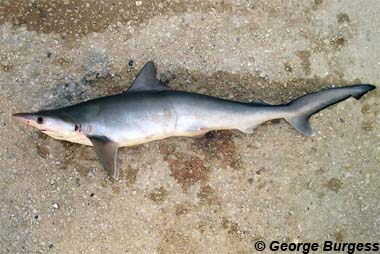
Rhizoprionodon acutus
This small requiem shark has the typical coloring of grey on top and white underneath, and grows to a slender 5 to 5.5 feet long. It has a distinctly pointed snout and large eyes. It is an abundant in-shore shark that is popular for subsistence and commercial fishing. Despite its preference for estuaries and surf zones, it is considered harmless to humans because of its size and teeth.
Order – Carcharhiniformes
Family – Carcharhinidae
Genus – Rhizoprionodon
Species – acutus
Common Names
English language common names include milk shark, fish shark, grey dog shark, grey dog-shark, Longmans dogshark, milk dog shark, milkshark, sharpnosed shark, sharp-nosed milk shark, and white-eye shark. Other common names are balda (Marathi), cazón lechero (Spanish), cazón lechoso (Spanish), cazón picudo (Spanish), chalarm paag-laem (Thai), co-sorrah (Tamil), eidah (Hindi), gaîndé goundaw (Arabic), hiragashira (Japanese), jarjur (Arabic), kayaruketty sravu (Malayalam), kitil-kitil (Kuyunon), kooseh-e-chak-lab (Persian), lézard (French), marajo (Spanish), marracho branco (Portuguese), melkhaai (Dutch), mooshi (Gujarati), mori (Marathi), mushi (Marathi), papa-marbui (Swahili), pating (Tagalog), perum sorrah (Malayalam), pisori (Gujarati), prionodontokarcharias (Greek), requin à museau pointu (French), requin à nez pointu (French), squalo latteo (Italian), taess (Arabic), tiukh ou thiour (Wolof), trey chhlam (Khmer), tsim tau sha (Cantonese), tubarão-bicudo (Portuguese), and yu (Malay).
Importance to Humans
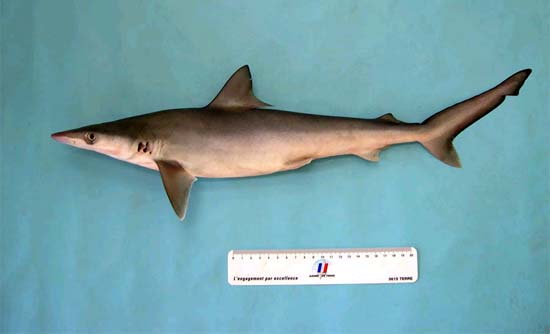
The milk shark is commonly taken in subsistence, artisanal, and commercial fisheries throughout its range. It is also taken as a game fish in recreational fisheries. It is sometimes utilized for its fins and meat but is of relatively little importance due to its small size. It is sold fresh at markets in the Indo-west Pacific region and is also utilized for fish meal.
Danger to Humans
The milk shark is harmless to humans due to its small size and feeding habits.
Conservation
As an abundant inshore shark species, the milk shark is commonly caught in subsistence, artisanal and commercial fisheries throughout its range. It is one of the most commonly taken shark species in the waters off northern Australia. Fortunately this has not affected the milk shark populations adversely in this area. The milk shark is commonly taken in gillnet and trawl fisheries in waters off of Indian where some assessment of populations has been attempted, primarily in the 1980s and early 1990s. Although results showed that this species was being under-exploited, the methods used for this assessment were questionable. Since this time, elasmobranch catches have increased dramatically in this region and it is likely that this species is becoming more heavily exploited.
> Check the status of the milk shark at the IUCN website.
The IUCN is a global union of states, governmental agencies, and non-governmental organizations in a partnership that assesses the conservation status of species.
Geographical Distribution
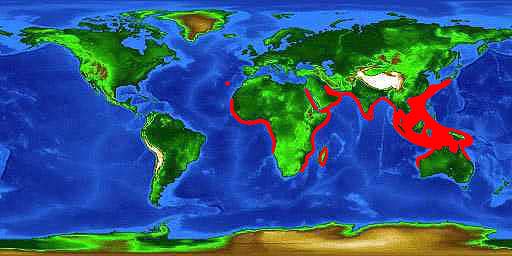
The milk shark, a tropical species, is found in the eastern Atlantic Ocean from Madeira and Mauritania south to Angola. This shark has also been reported from the Gulf of Taranto. In the Indo-West Pacific region, it is distributed from the Red Sea and East African coast to Indonesia, north to Japan and south to Australia.
Habitat
Residing on continental shelves in close proximity to sandy beaches and sometimes reported in estuaries, the milk shark occurs close to the surface in shallow waters to depths of 656 feet (200 m). It has also been reported to enter freshwater habitats including several instances in Cambodia.
Biology
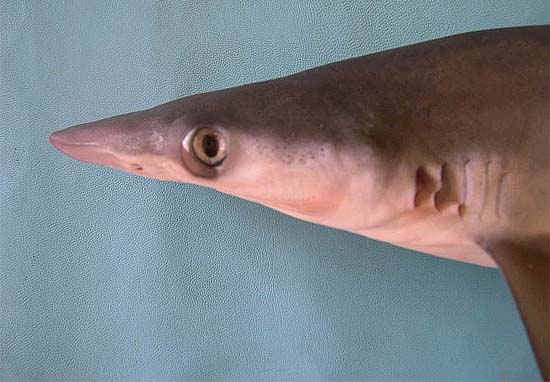
Distinctive Features
The milk shark is a small fusiform slender shark with a narrow snout and large eyes. The mouth has long labial folds at the corners that distinguish this species from other requiem sharks. The first dorsal fin origin ranges from just anterior to just posterior the free rear tips of the pectoral fins. The second dorsal fin is small and is located posterior to the larger anal fin. The anal fin has a slightly concave posterior margin and a pair of long pre-anal ridges. There is no interdorsal ridge.
Coloration
The dorsal surface of the milk shark is grey to grey-brown, fading to a white ventral surface. The fins of the milk shark are slightly darker than the body color. The dorsal and upper caudal fins have dusky or blackish edges. The pectoral, pelvic, anal, and lower caudal fin tips are pale. The pectoral fins have pale posterior margins.
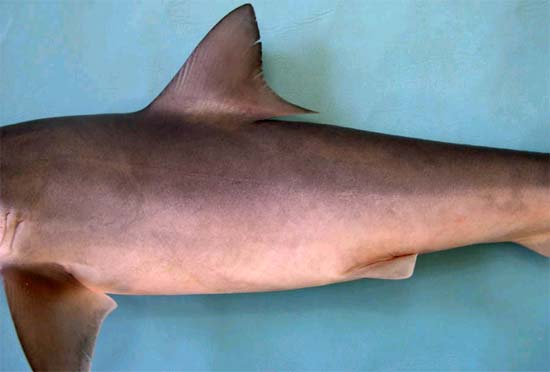
Dentition
The teeth are similar in both the upper and the lower jaws. Juvenile milk sharks have oblique, narrowly triangular smooth-edged teeth while the teeth of adult milk sharks are finely serrated.
Size, Age, and Growth
Milk sharks may reach a maximum total length of 5.7 feet (1.75 m). The maximum reported age is 8 years. Sexual maturity of male milk sharks is reached at total lengths of 24.8-28.0 inches (63-71 cm) while females reach maturity at 24.4-29.1 inches (62-74 cm) total length.
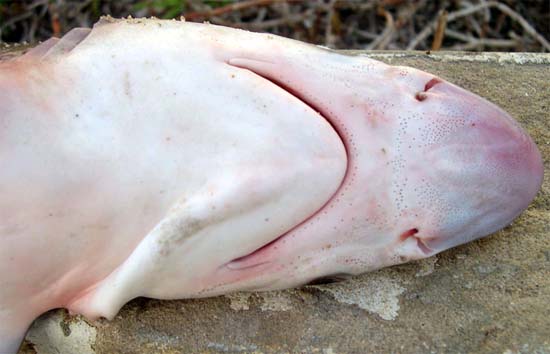
Food Habits
Prey items of the milk shark include small benthic and pelagic fishes as well as cephalopods and other invertebrates. Sharks use electroreception (ampullae of Lorenzini) for capturing prey. The ampullae of Lorenzini (see photo above) are receptors that can detect weak electric fields. This sense is unique to sharks and their relatives. Sharks primarily use this sense to locate cryptic prey which can not be detected by their other senses, such as stingrays buried in sand.
Reproduction
The milk shark is viviparous with a yolk sac placenta. Indian and South African population give birth during the months of January and February following a one year gestation period. Mature females give birth every year. The number of pups in each litter is correlated with the size of the female. Litters contain 1-6 pups, each of which measures 9.8-15.4 inches (25-39 cm) at birth.

Predators
The blacktip shark (Carcharhinus limbatus) and the Australian blacktip shark (Carcharhinus tilstoni) are known predators of the milk shark. Other potential predators include large marine mammals and large fish including other sharks.
Parasites
Parasites of the milk shark include copepods.
Taxonomy
This requiem shark was originally described by Rüppell in 1837 as Carcharias acutus. The scientific name was later changed to the currently valid name, Rhizoprionodon acutus (Rüppell 1837). The genus name Rhizoprionodon is derived from the Greek, “rhiza” = root, “prion” = saw, and “odous” = teeth. Synonyms referring to this species in past scientific literature include Carcharias walbeehmi Bleeker 1856, Carcharias walbeehmii Bleeker 1856, Carcharias walbeehmii Bleeker 1856, Scoliodon walbeehmii Bleeker 1856, Scoliodon walbeemii Bleeker 1856, Carcharias walbenii Bleeker 1856, Scolliodon walbechmii Bleeker 1856, Scoliodon walbeehmi Bleeker 1856, Carcharias crenidens Klunzinger 1880, Carcharias aaronis Hemprich & Ehrenberg 1899, Scoliodon longmani Ogilby 1912, Carcharias eumeces Pietschmann 1913, and Scoliodon vagatus Garman 1913. This shark is commonly referred to as the milk shark because in some regions it is believed that eating the flesh of this shark will improve the milk production of a human mother. It is the mostly widely distributed shark in the genus Rhizoprionodon.
Prepared by: Cathleen Bester